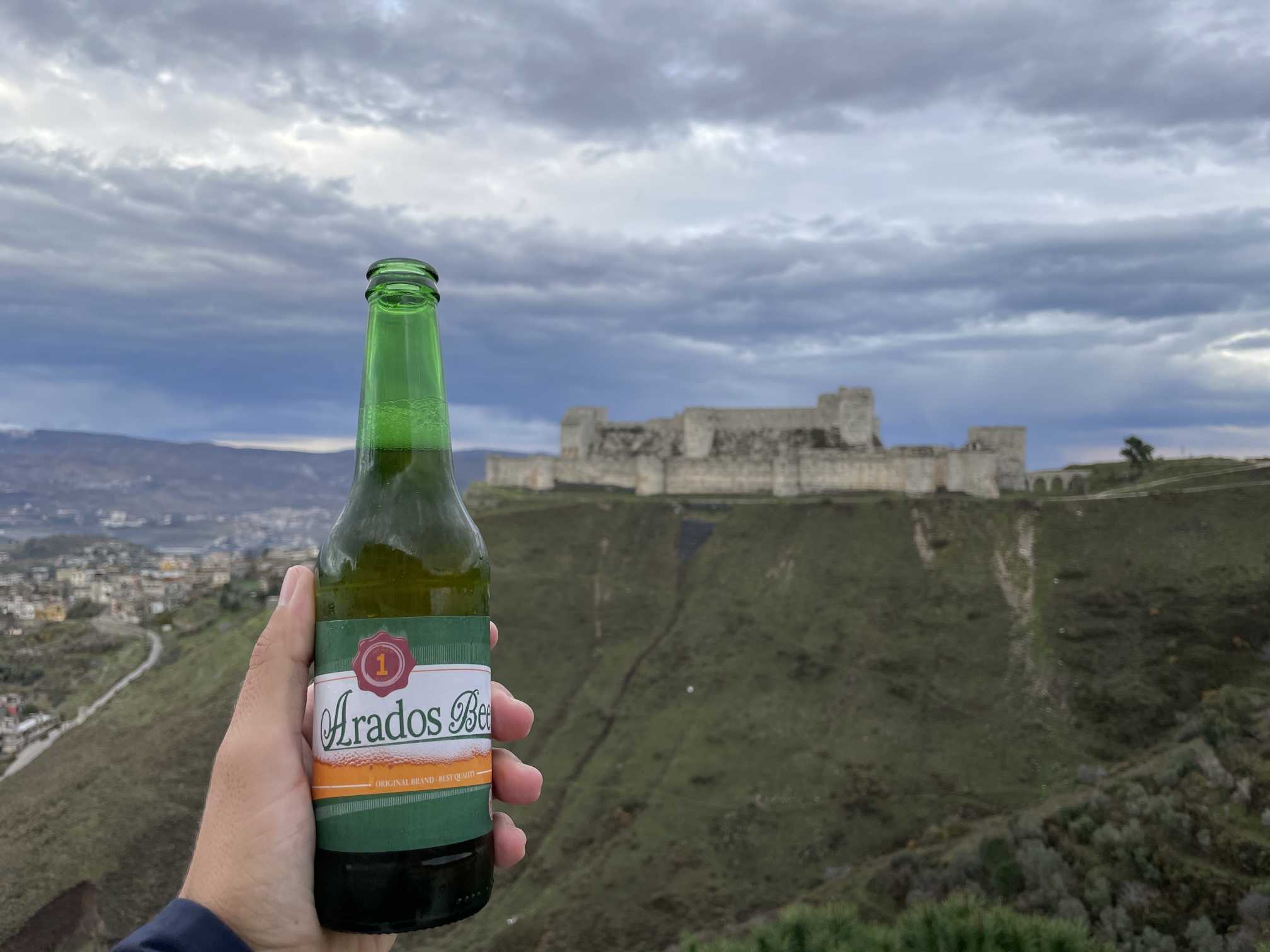
Syrian Beer
Have you heard about Syrian beer story ? although brands like Lebanese Almaza, Heineken and Amstel are popular and available in hotels, restaurants and most shops in different parts of cities like Damascus, Aleppo, Latakia, Tartus and Qamishli. Production of the country's two local brands, al-Shark (from Aleppo) and Barada (from Damascus) was halted in 2011 due to the outbreak of war. Al-Shark Beer, (or al-Chark) is a product of the state-owned Al-Shark Company for Food Stuff Products in Aleppo. It was founded in 1954 and fully owned by the government of Syria Barada Beer, is a product of the state-owned Barada Beer Company in Damascus. It was founded in 1977 and fully owned by the government of Syria. Afamia Beer of Syria, founded in 2010 and launched in 2 ...are popular and available in hotels, restaurants and most shops in different parts of cities like Damascus, Aleppo, Latakia, Tartus and Qamishli. Production of the country's two local brands, al-Shark (from Aleppo) and Barada (from Damascus) was halted in 2011 due to the outbreak of war. Al-Shark Beer, (or al-Chark) is a product of the state-owned Al-Shark Company for Food Stuff Products in Aleppo. It was founded in 1954 and fully owned by the government of Syria Barada Beer, is a product of the state-owned Barada Beer Company in Damascus. It was founded in 1977 and fully owned by the government of Syria. Afamia Beer of Syria, founded in 2010 and launched in 2017 by Afamia Beverages Company; . Afamia brewery has invested in state-of-the-art equipment and technology along with European expertise and raw material to produce Syria's first premium beer Arados Beer, launched in 2017 by the Arados brewing factory in Safita, Tartus Governorate, with the help of experts from the Czech Republic. It is the latest company for beer production in Syria, . Arados brewery of Safita represents the first mass-produced domestic beer since production of al-Shark and Barada ceased, following the outbreak of the war in Syria. Cheers #Syria #beer #Syria_beer #Damascus_beer #Arados_beer #Afamia_beer #Barada_beer #Shark_beer #try_syrian_beer #syria_beer_story #Syria2022 #Syria_new_year #tourism #syria_visa #syria_tour #tour_operators #beer_History #Marrota_tourism #ayoub_from_Syria #Syria_guide #visit_syria #beer_factory_syria #syrian_beer_2022
Read more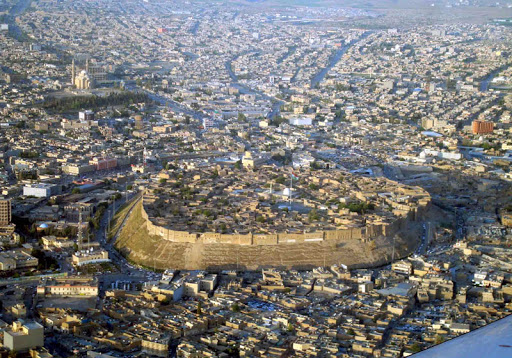
The Citadel of Erbil
The Citadel, is a hill or occupied mound, and the historical city centre of Erbil in the Kurdistan Region of Iraq. The citadel has been inscribed on the World Heritage List since 21 June 2014. The earliest evidence for occupation of the citadel mound dates to the 5th millennium BC, and possibly earlier. It appears for the first time in historical sources in the Ebla tablets around 2,300 BC, and gained particular importance during the Neo-Assyrian period. During the Sassanian period and the Abbasid Caliphate, Erbil was an important centre for Christianity. After the Mongols captured the citadel in 1258, the importance of Erbil declined. During the 20th century, the urban structure was significantly modified, as a result of which a number of house ...Kurdistan Region of Iraq. The citadel has been inscribed on the World Heritage List since 21 June 2014. The earliest evidence for occupation of the citadel mound dates to the 5th millennium BC, and possibly earlier. It appears for the first time in historical sources in the Ebla tablets around 2,300 BC, and gained particular importance during the Neo-Assyrian period. During the Sassanian period and the Abbasid Caliphate, Erbil was an important centre for Christianity. After the Mongols captured the citadel in 1258, the importance of Erbil declined. During the 20th century, the urban structure was significantly modified, as a result of which a number of houses and public buildings were destroyed. In 2007, the High Commission for Erbil Citadel Revitalization (HCECR) was established to oversee the restoration of the citadel. The buildings on top of the tell stretch over a roughly oval area of 430 by 340 meters (1,410 ft × 1,120 ft.) occupying 102,000 square meters (1,100,000 sq ft). The only religious structure that currently survives is the Mulla Afandi Mosque. The mound rises between 25 and 32 meters (82 and 105 ft) from the surrounding plain. When it was fully occupied, the citadel was divided in three districts or mahallas: from east to west the Serai, the Takya and the Topkhana. The Serai was occupied by notable families; the Takya district was named after the homes of dervishes, which are called takyas; and the Topkhana district housed craftsmen and farmers.
Read more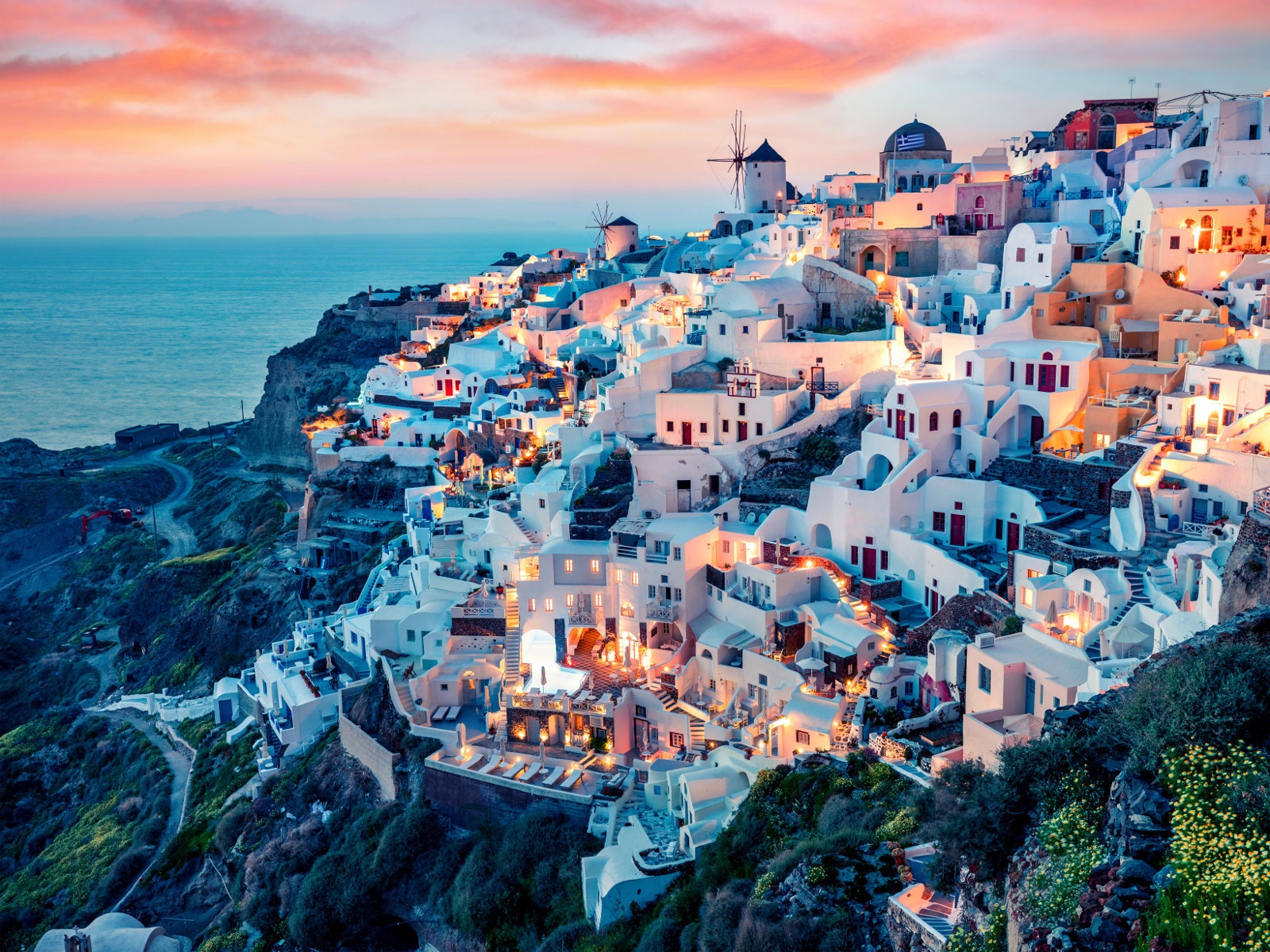
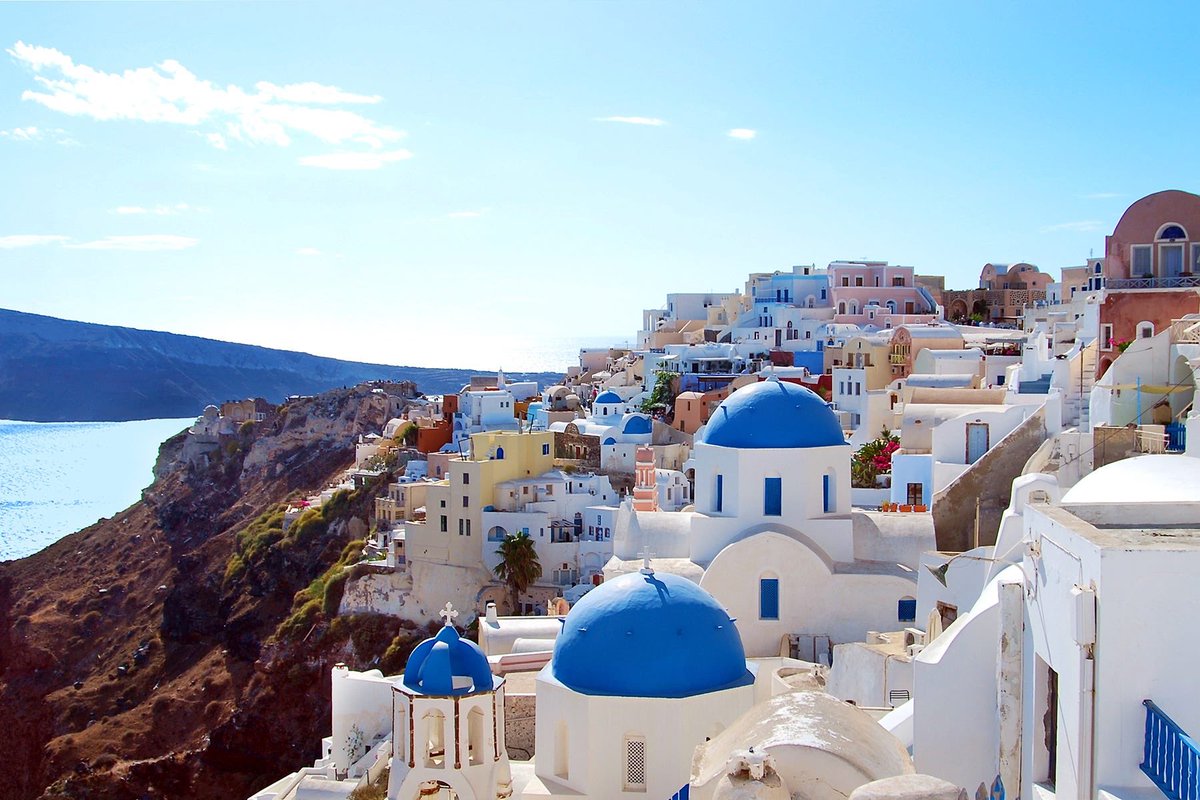
Santorini
Crescent-shaped Santorini (or Thíra), the precious gem of the Aegean, is actually a group of islands consisting of Thíra, Thirassiá, Asproníssi, Palea and Nea Kaméni in the southernmost part of Cyclades. the whole complex of Santorini islands is still an active volcano (the same as Méthana, Mílos and Nísiros) and probably the only volcano in the world whose crater is in the sea? The islands that form Santorini came into existence as a result of intensive volcanic activity; twelve huge eruptions occurred, one every 20,000 years approximately, and each violent eruption caused the collapse of the volcano’s central part creating a large crater (caldera). The volcano, however, managed to recreate its ...roup of islands consisting of Thíra, Thirassiá, Asproníssi, Palea and Nea Kaméni in the southernmost part of Cyclades. the whole complex of Santorini islands is still an active volcano (the same as Méthana, Mílos and Nísiros) and probably the only volcano in the world whose crater is in the sea? The islands that form Santorini came into existence as a result of intensive volcanic activity; twelve huge eruptions occurred, one every 20,000 years approximately, and each violent eruption caused the collapse of the volcano’s central part creating a large crater (caldera). The volcano, however, managed to recreate itself over and over again. The last big eruption occurred 3,600 years ago (during the Minoan Age), when igneous material (mainly ash, pumice and lava stones) covered the three islands (Thíra, Thirassiá and Asproníssi). The eruption destroyed the thriving local prehistoric civilization, evidence of which was found during the excavations of a settlement at Akrotíri. The solid material and gases emerging from the volcano’s interior created a huge “vacuum” underneath, causing the collapse of the central part and the creation of an enormous “pot” –today’s Caldera– with a size of 8x4 km and a depth of up to 400m below sea level. The eruption of the submarine volcano Kolúmbo, located 6.5 km. NE of Santorini, on 27th September 1650, was actually the largest recorded in Eastern Mediterranean during the past millennium! The most recent volcanic activity on the island occurred in 1950. The whole island is actually a huge natural geological/volcanological museum where you can observe a wide range of geological structures and forms! Santorini is considered to be the most sought after place for a romantic getaway in Greece, since there are not many places in the world where you can enjoy exquisitely clear waters while perched on the rim of a massive active volcano in the middle of the sea! The island has a growing reputation as a “wedding destination” for couples not only from Greece but from all over the world.
Read more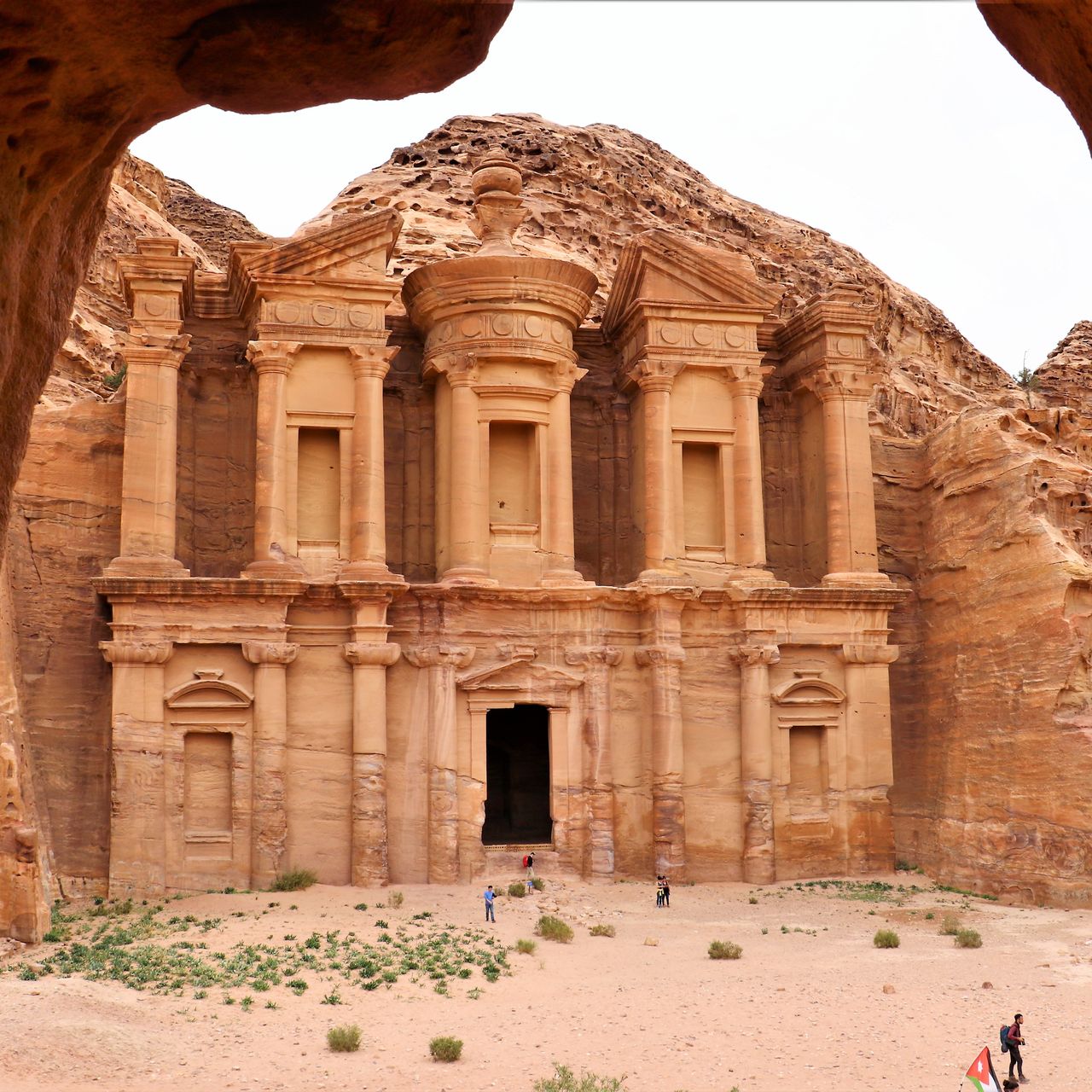
Petra
Inhabited since prehistoric times, this Nabataean caravan-city, situated between the Red Sea and the Dead Sea, was an important crossroads between Arabia, Egypt and Syria-Phoenicia. Petra is half-built, half-carved into the rock, and is surrounded by mountains riddled with passages and gorges. It is one of the world's most famous archaeological sites, where ancient Eastern traditions blend with Hellenistic architecture. Situated between the Red Sea and the Dead Sea and inhabited since prehistoric times, the rock-cut capital city of the Nabateans, became during Hellenistic and Roman times a major caravan centre for the incense of Arabia, the silks of China and the spices of India, a crossroads between Arabia, Egypt and Syria-Phoenicia. Petra is half-bui ... and the Dead Sea, was an important crossroads between Arabia, Egypt and Syria-Phoenicia. Petra is half-built, half-carved into the rock, and is surrounded by mountains riddled with passages and gorges. It is one of the world's most famous archaeological sites, where ancient Eastern traditions blend with Hellenistic architecture. Situated between the Red Sea and the Dead Sea and inhabited since prehistoric times, the rock-cut capital city of the Nabateans, became during Hellenistic and Roman times a major caravan centre for the incense of Arabia, the silks of China and the spices of India, a crossroads between Arabia, Egypt and Syria-Phoenicia. Petra is half-built, half-carved into the rock, and is surrounded by mountains riddled with passages and gorges. An ingenious water management system allowed extensive settlement of an essentially arid area during the Nabataean, Roman and Byzantine periods. It is one of the world's richest and largest archaeological sites set in a dominating red sandstone landscape. The Outstanding Universal Value of Petra resides in the vast extent of elaborate tomb and temple architecture; religious high places; the remnant channels, tunnels and diversion dams that combined with a vast network of cisterns and reservoirs which controlled and conserved seasonal rains, and the extensive archaeological remains including of copper mining, temples, churches and other public buildings. The fusion of Hellenistic architectural facades with traditional Nabataean rock-cut temple/tombs including the Khasneh, the Urn Tomb, the Palace Tomb, the Corinthian Tomb and the Deir ("monastery") represents a unique artistic achievement and an outstanding architectural ensemble of the first centuries BC to AD. The varied archaeological remains and architectural monuments from prehistoric times to the medieval periods bear exceptional testimony to the now lost civilisations which succeeded each other at the site.
Read more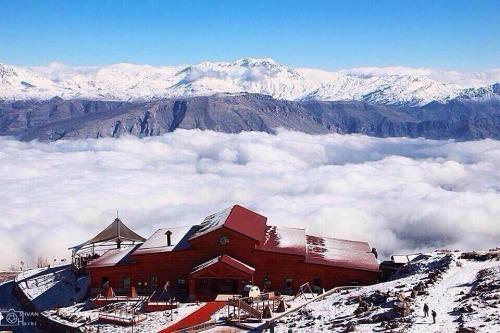
Korek Mountain
It is a mountain in town of Rawanduz, Erbil in Iraq Kurdistan, 50 kilometers from the Iranian border . Mount Korek is a tourist attraction with, an Iraqi company has built an approximately 4 kilometer long Teleferic (cable car) from its Bekhal Bottom station to Mount Korek. The mountain is developed as an international destination. The company has developed 132 villas and several rides in this project, which is called "The Korek Mountain Resort & Spa". There are also restaurants and cafes. The resort is a summer retreat providing cool environs when the whole region reels under high temperatures. During winters, it turns into a Ski Resort.The Resort is one of the top 10 destinations to visit in the Kurdistan region of Iraq. ... . Mount Korek is a tourist attraction with, an Iraqi company has built an approximately 4 kilometer long Teleferic (cable car) from its Bekhal Bottom station to Mount Korek. The mountain is developed as an international destination. The company has developed 132 villas and several rides in this project, which is called "The Korek Mountain Resort & Spa". There are also restaurants and cafes. The resort is a summer retreat providing cool environs when the whole region reels under high temperatures. During winters, it turns into a Ski Resort.The Resort is one of the top 10 destinations to visit in the Kurdistan region of Iraq.
Read more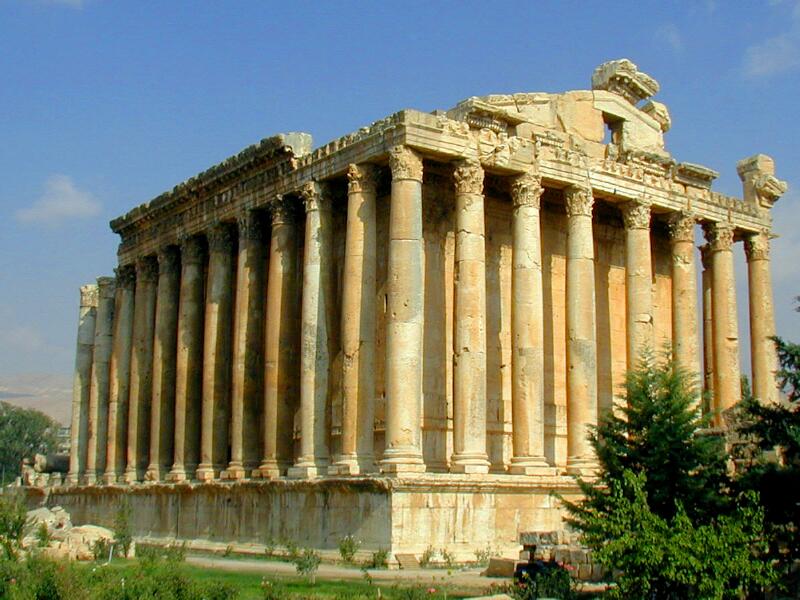
Baalbek
This Phoenician city, where a triad of deities was worshipped, was known as Heliopolis during the Hellenistic period. It retained its religious function during Roman times, when the sanctuary of the Heliopolitan Jupiter attracted thousands of pilgrims. Baalbek, with its colossal structures, is one of the finest examples of Imperial Roman architecture at its apogee. The complex of temples at Baalbek is located at the foot of the south-west slope of Anti-Lebanon, bordering the fertile plain of the Bekaa at an altitude of 1150 m. The city of Baalbek reached its apogee during Roman times. Its colossal constructions built over a period of more than two centuries, make it one of the most famous sanctuaries of the Roman world and a model of Imperial R ...g the Hellenistic period. It retained its religious function during Roman times, when the sanctuary of the Heliopolitan Jupiter attracted thousands of pilgrims. Baalbek, with its colossal structures, is one of the finest examples of Imperial Roman architecture at its apogee. The complex of temples at Baalbek is located at the foot of the south-west slope of Anti-Lebanon, bordering the fertile plain of the Bekaa at an altitude of 1150 m. The city of Baalbek reached its apogee during Roman times. Its colossal constructions built over a period of more than two centuries, make it one of the most famous sanctuaries of the Roman world and a model of Imperial Roman architecture. Pilgrims thronged to the sanctuary to venerate the three deities, known under the name of the Romanized Triad of Heliopolis, an essentially Phoenician cult (Jupiter, Venus and Mercury). The importance of this amalgam of ruins of the Greco-Roman period with even more ancient vestiges of Phoenician tradition, are based on its outstanding artistic and architectural value. The acropolis of Baalbek comprises several temples. The Roman construction was built on top of earlier ruins which were formed into a raised plaza, formed of twenty-four monoliths, the largest weighing over 800 tons. The Temple of Jupiter, principal temple of the Baalbek triad, was remarkable for its 20 m high columns that surrounded the cella, and the gigantic stones of its terrace. The adjacent temple dedicated to Bacchus is exceptional; it is richly and abundantly decorated and of impressive dimensions with its monumental gate sculpted with Bacchic figures. The Round Temple or Temple of Venus differs in its originality of layout as well as its refinement and harmonious forms, in a city where other sanctuaries are marked by monumental structures. The only remaining vestige of the Temple of Mercury located on Cheikh Abdallah Hill, is a stairway carved from the rock. The Odeon, located south of the acropolis in a place known as Boustan el Khan, is also part of the Baalbek site, and considered among the most spectacular archaeological sites of the Near East. Baalbek became one of the most celebrated sanctuaries of the ancient world, progressively overlaid with colossal constructions, which were built during more than two centuries. Its monumental ensemble is one of the most impressive testimonies of the Roman architecture of the imperial period.
Read more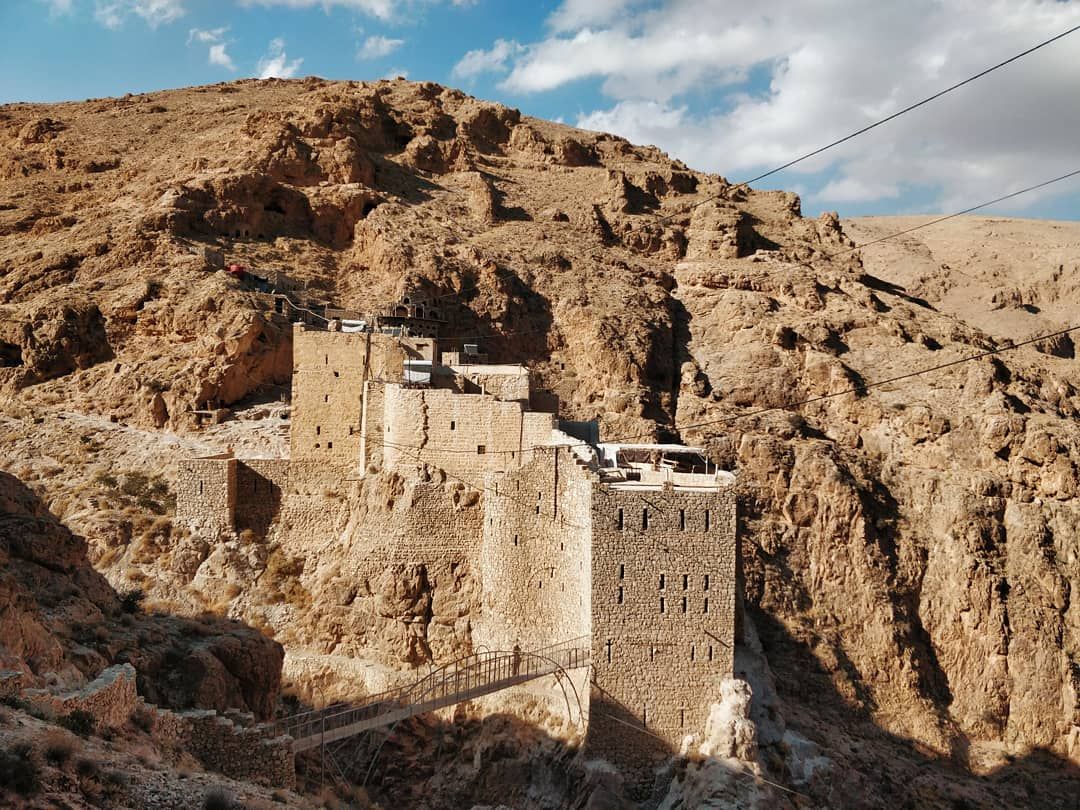
Monastery of Mar Musa
The ancient Syrian monastery of St. Moses the Abyssinian (Deir Mar Musa el-Habashi) overlooks a harsh valley in the mountains east of the small town of Nabk, 80 km north of Damascus. It is about 1320 meters above sea level. Mar Mousa began, as a 2nd; century Roman outpost tower then in the 5th century became a home for Christian monks. In the 1100, the church was built. Then it was abandoned after the 1800's until 1982 when Father Paolo, a priest made renovating the monastery and the church with its precious frescoes a personal passion among many projects. This ancient Catholic monastery houses world-renowned wall frescos Any wandering traveler is welcome to enter the monastery and stay the night, so long as they participate in community chore ...s a harsh valley in the mountains east of the small town of Nabk, 80 km north of Damascus. It is about 1320 meters above sea level. Mar Mousa began, as a 2nd; century Roman outpost tower then in the 5th century became a home for Christian monks. In the 1100, the church was built. Then it was abandoned after the 1800's until 1982 when Father Paolo, a priest made renovating the monastery and the church with its precious frescoes a personal passion among many projects. This ancient Catholic monastery houses world-renowned wall frescos Any wandering traveler is welcome to enter the monastery and stay the night, so long as they participate in community chores and respect the monastery rules. While camouflaged among the burnt brown stone of the towering valley walls, the site itself remains an imposing edifice. The monastery is built high onto the mountains rimming the valley, and it takes 30 minutes of walking up a path of narrowly stacked stairs to reach the entrance gate. Each step creates a sensation of walking back in time, with only a single cable cord (used to transport food goods from the valley floor) marring an image that has remained largely unchanged in the last thousand years. However, the medieval ambiance is misleading, for inside the ancient stone walls is a community that has seamlessly woven both modernity and tradition into their lifestyle. Electric lights are turned on following the daily hour of silence, the Monastery’s leader preaches in a room decorated with 800-year old frescos of Christ, Deir Mar Musa is a beacon of hope in a war-torn country, and offers an inspiring layover for travelers who wish to better understand and appreciate the nuances of Syrian culture.asdad
Read more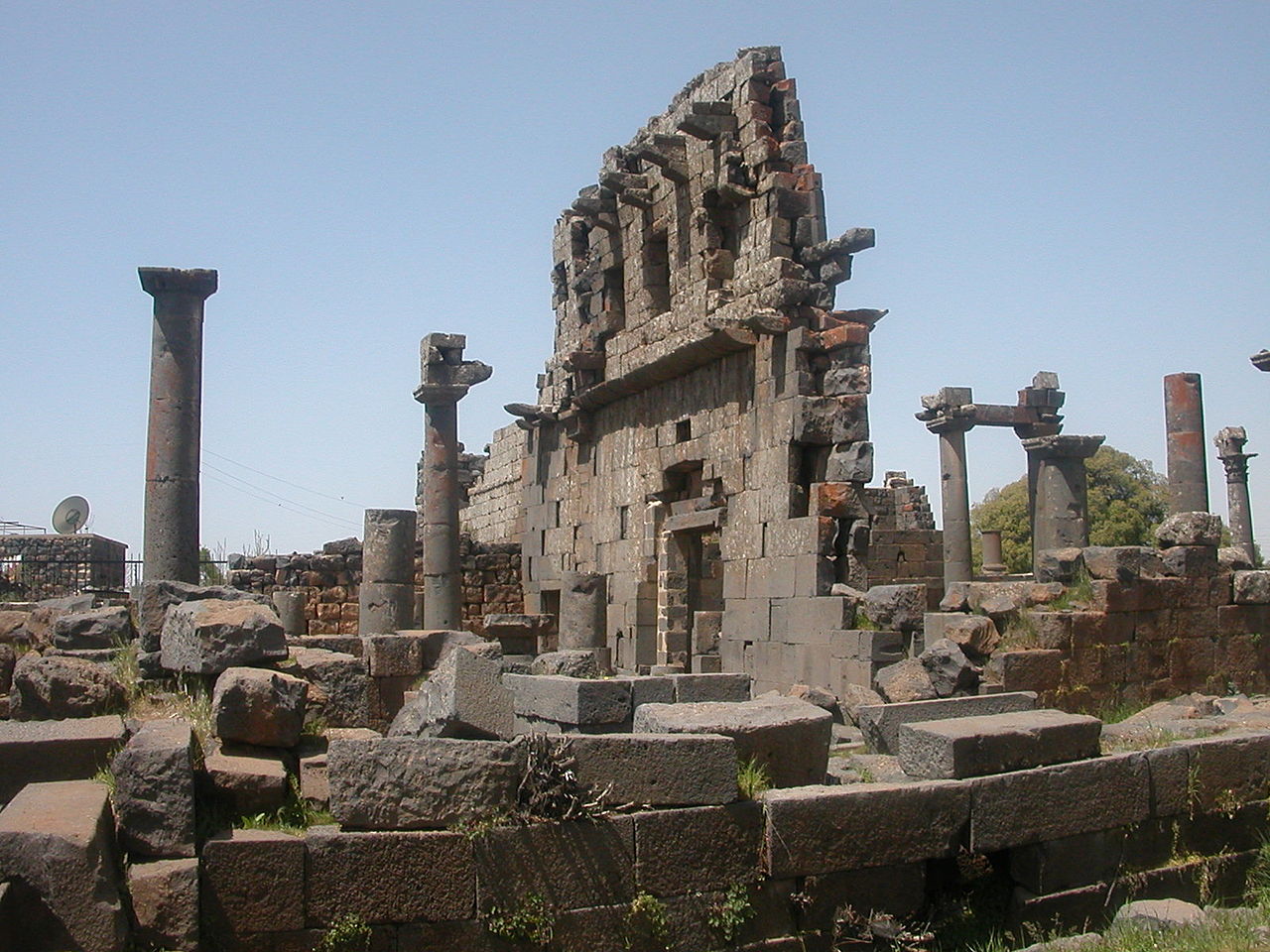
Qanawat
The city of Qanawat or Kanatha is an ancient Syrian city located seven kilometers northeast of al-Suwayda. Located in the south of the Syrian Arab Republic, ninety-five kilometers southeast of Damascus, an altitude of more than one thousand two hundred and fifty meters from the surface the sea Qanawat city divided into two parts, a southern upper city, and a northern lower city, which was built entirely of black basaltic stones, giving it an attractive and strange appearance. The name Kanatha, the ancient name of the city of Qanawat, was found on ancient Roman coins and inscriptions, as it was written next to the names of the emperors and leaders who ruled this area at the time, so the name Septima Kanatha was named after Emperor Septimius ...of al-Suwayda. Located in the south of the Syrian Arab Republic, ninety-five kilometers southeast of Damascus, an altitude of more than one thousand two hundred and fifty meters from the surface the sea Qanawat city divided into two parts, a southern upper city, and a northern lower city, which was built entirely of black basaltic stones, giving it an attractive and strange appearance. The name Kanatha, the ancient name of the city of Qanawat, was found on ancient Roman coins and inscriptions, as it was written next to the names of the emperors and leaders who ruled this area at the time, so the name Septima Kanatha was named after Emperor Septimius Severus, and the name of Gabina Kanatha is relative to Emperor Gabinus. The activity of the inhabitants of the city of Kanatha extended to all parts of the Roman Empire, where a Greek scripture monument was found at a site near the city of Lyon, France, bearing a memorial to one of the merchants of the then Kanatha called Tim bin Saad, and this confirms the arrival of the people of the city of canals with their trade to different parts of Europe. A Syrian-German mission excavated a number of discovered buildings in the region, and they were able to discover during this period many important archaeological temples, Remains of Christian temples, dating back to the Byzantine and Roman period, in addition to many of rock carvings that indicate the life of these civilizations. In addition, they discovered the small theater, which was designated for concerts and accommodated more than three thousand people. The site of the northern tombs, which was one of the results of recent excavations, and found many of pottery, glass vessels, silver and bronze coins, chains made of beads, bronze bracelets, rings, in addition to gold foil, basaltic sculptures, statues, and Greek writings.
Read more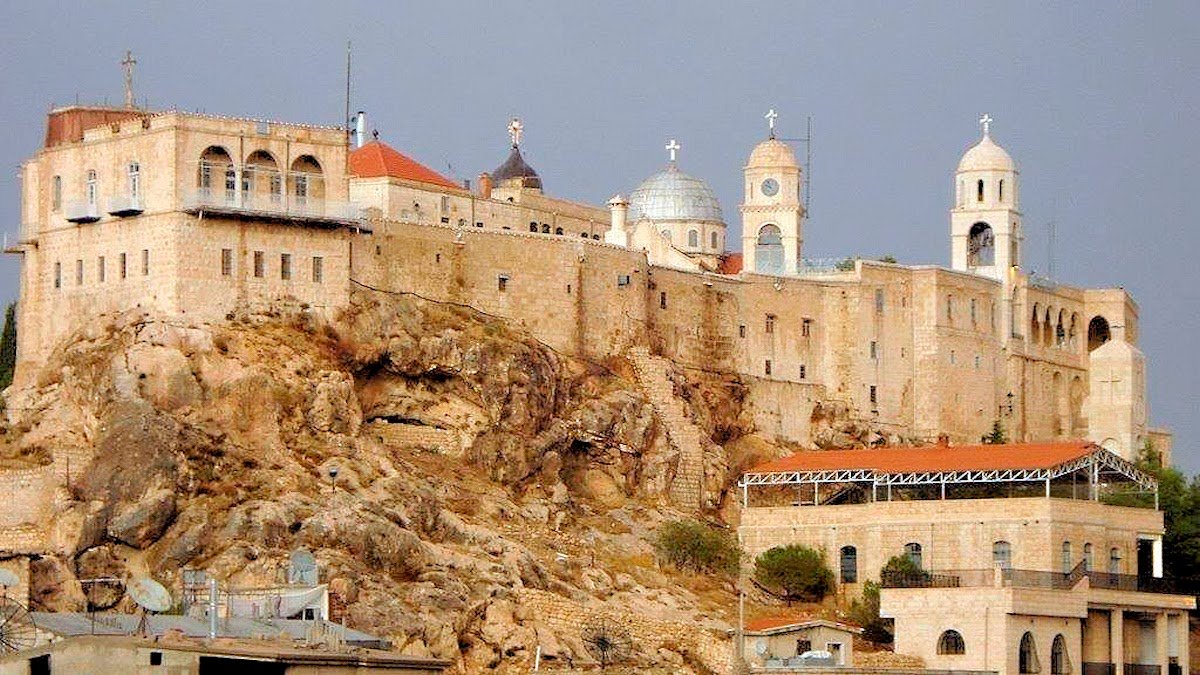
Saydnaya
It is a city located in the mountains, 1,500 m (4,900 ft.) above sea level, 27 km (17 mi) north of the city of Damascus in Syria. It is the home of a Greek Orthodox monastery traditionally held to have been founded by Byzantine emperor Justinian I, and where a renowned icon of the Virgin Mary is revered by both Christians and Muslims to this day. The town is noted for the large number of Aramaic speakers, along with nearby Maaloula and few smaller towns nearby. The Lady Virgin Monastery story said that Justinian I, Emperor of Byzantium, while crossing Syria with his troops either on his way to the Holy Land or on a campaign against the Persians, came to this desert, where his army encamped and soon suffered thirst for lack of water. When they despa ...rth of the city of Damascus in Syria. It is the home of a Greek Orthodox monastery traditionally held to have been founded by Byzantine emperor Justinian I, and where a renowned icon of the Virgin Mary is revered by both Christians and Muslims to this day. The town is noted for the large number of Aramaic speakers, along with nearby Maaloula and few smaller towns nearby. The Lady Virgin Monastery story said that Justinian I, Emperor of Byzantium, while crossing Syria with his troops either on his way to the Holy Land or on a campaign against the Persians, came to this desert, where his army encamped and soon suffered thirst for lack of water. When they despaired, the emperor saw a beautiful deer off in the distance. He vigorously gave chase, hunting the animal until it tired and stopped on a rocky knoll and approached a spring of fresh water, but without giving the emperor the opportunity to shoot it. Suddenly, it transformed into an icon of the Theotokos. Which shone with a brilliant light. A white hand stretched forth from it and a voice said, "No, thou shalt not kill me, Justinian, but thou shalt build a church for me here on this hill." Then the strange heavenly light and majestic figure disappeared. Upon his return, Justinian related what he had seen to his subordinates and ordered them immediately to draw up a plan for the contemplated church. After some time had passed and the architects were unable to resolve the problems of the plan, the Holy Virgin — the deer — reappeared to Justinian in a dream and confided a magnificent plan to him for a convent, of which she would be the Protectors. It is said that the basic structure of the convent follows this plan to this day. The convent soon gained such renown that it came to be ranked second only to Jerusalem as a place of pilgrimage, and nuns from every corner of Syria, Egypt, and other lands flocked to it. The holy Icon El Chagoura appeared many years after the convent was constructed. Another important part in Saydnaya is the statue of Christ in Cherubim Monastery, which considered the second largest statue after the Christ statue in Rio de Janeiro.
Read more
Hama
The city is 200km to the north of Damascus and 60km to the east of Banyas. It is a very ancient city, which has flourished continually since ancient times, and has known the successive divinations of the Fertile Crescent. Hama has a long heroic history in defending Syria against foreign invasion. One of the outstanding battles was that of Qarqar, where the Assyrian army was defeated in 853B.C. Unfortunately, few of its ancient relics have been preserved. However, Hama is well known for its enormous waterwheels (norias) on the Orontes, which are as old as Hama itself. One of the ancient buildings in Hama is al Jami al kabir (the great mosque), which dates back to the 14th century and includes two tombs of two emirs who ruled Hama in the 13th century. Anothe ..., which has flourished continually since ancient times, and has known the successive divinations of the Fertile Crescent. Hama has a long heroic history in defending Syria against foreign invasion. One of the outstanding battles was that of Qarqar, where the Assyrian army was defeated in 853B.C. Unfortunately, few of its ancient relics have been preserved. However, Hama is well known for its enormous waterwheels (norias) on the Orontes, which are as old as Hama itself. One of the ancient buildings in Hama is al Jami al kabir (the great mosque), which dates back to the 14th century and includes two tombs of two emirs who ruled Hama in the 13th century. Another mosque is that of Abu al Fida, named after Hama`s Sultan who was a famous Arab geographer and historian. The city is often linked with his name. A third mosque is the al Nuri mosque, which was built in the days of Noureddin al Zanki in 1129; on its wall appear inscriptions in both Arabic and Greek. Hama is particularly famous for its traditional industries, especially textiles and cotton cloth.
Read more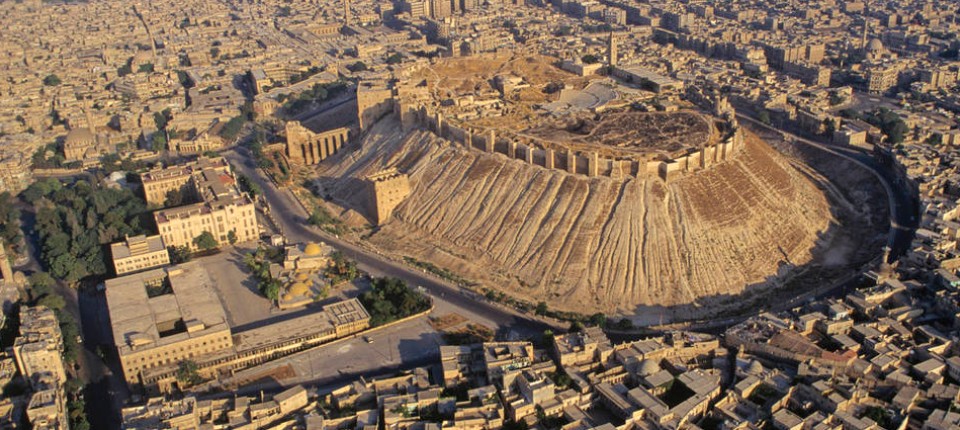
Aleppo
This is the second capital of Syria (350 km north of Damascus) and one of the oldest continuously inhabited cities in history. Abraham is said to have camped on the acropolis, which, long before his time, served as the foundation of a fortress (where the Aleppo citadel is standing now) Ever since the 3rd millennium B.C., Aleppo has been a flourishing city, with a unique strategic position which gave the city a distinctive role from the days of the Akkadian and Amorite kingdoms until modern times. It was the meeting-point of several important commercial roads in the north. This enabled Aleppo to be the link in trade between Mesopotamia, the Fertile Crescent and Egypt. The Amorites made it there capital in the 18th century B.C. Thi ...nuously inhabited cities in history. Abraham is said to have camped on the acropolis, which, long before his time, served as the foundation of a fortress (where the Aleppo citadel is standing now) Ever since the 3rd millennium B.C., Aleppo has been a flourishing city, with a unique strategic position which gave the city a distinctive role from the days of the Akkadian and Amorite kingdoms until modern times. It was the meeting-point of several important commercial roads in the north. This enabled Aleppo to be the link in trade between Mesopotamia, the Fertile Crescent and Egypt. The Amorites made it there capital in the 18th century B.C. This position however made it subject to invasion from: Hittites, Egyptians, Assyrians, Persians Greeks and Romans. Aleppo was prominent in the Christian era; it became a bishopric and a huge cathedral was built in it, which is still standing. The conflict between Byzantium and Persia, however, resulted in the latter s occupation of Aleppo in 440. The Persians robbed the city, burned considerable parts of it and damaged many of its features. Though expelled by Justinian, the Persians kept threatening Aleppo and frightened its inhabitants until the Arab Islamic conquest came in 636. The city then regained its status, both cultural and commercial. Apart from the Omayyad and Abbassid periods in which Aleppo flourished, the Hamadani state established by Sayf al- Dawla in 944 made Aleppo the northern capital of Syria. Saif al Dawala built Aleppo s famous citadel, and his days the city enjoyed great prosperity and fame in science, literature and medicine despite this leader s military occupations. Aleppo was famous for its architecture; for its attractive churches, mosques, schools, tombs, and baths. As an Important center of trade between the eastern Mediterranean kingdoms and the merchants of Venice. In the Ottoman age, Aleppo remained an important center of trade with Turkey, France, England and Holland. This caused various types of European architecture to be adopted in Aleppo, which can be seen in many buildings today.
Read more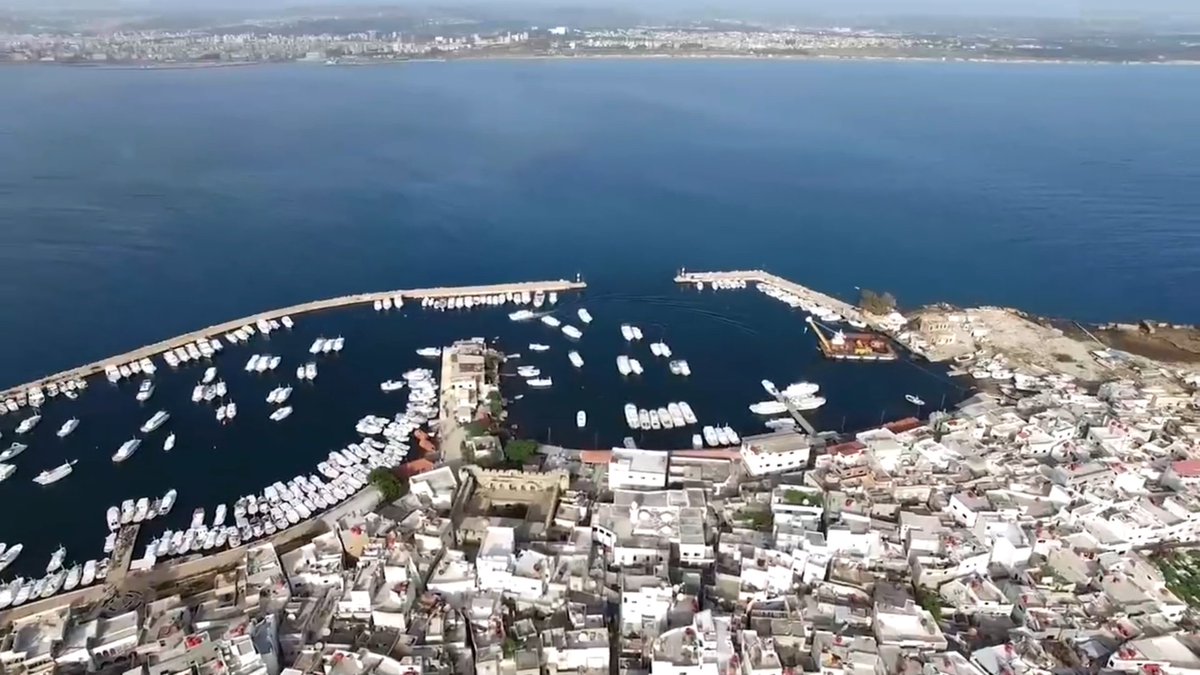
Arwad
This is the only island in Syria, and its located 3km from Tartus. It was an independent kingdom named Aradus in the days of Caanaanites. It was often mentioned in inscriptions because of its importance in commerce and seafaring. Arwad provided shelter for those escaping from foreign invasions in ancient times. Especially for the people of Amrit in the south of Tartus. Amrit still retains its name since the 5th century B.C. It has temple surrounded by water. Arwad is a beautiful small island, which a mass of houses and fortresses with narrow lanes. It has many cafés and restaurants overlooking Tartus and the sea. Its ancient citadel was used as a prison for the nationalists during the resistance against the French. The wall of some cells in ...ndent kingdom named Aradus in the days of Caanaanites. It was often mentioned in inscriptions because of its importance in commerce and seafaring. Arwad provided shelter for those escaping from foreign invasions in ancient times. Especially for the people of Amrit in the south of Tartus. Amrit still retains its name since the 5th century B.C. It has temple surrounded by water. Arwad is a beautiful small island, which a mass of houses and fortresses with narrow lanes. It has many cafés and restaurants overlooking Tartus and the sea. Its ancient citadel was used as a prison for the nationalists during the resistance against the French. The wall of some cells in this citadel are still covered with the graffiti of the nationalists.
Read more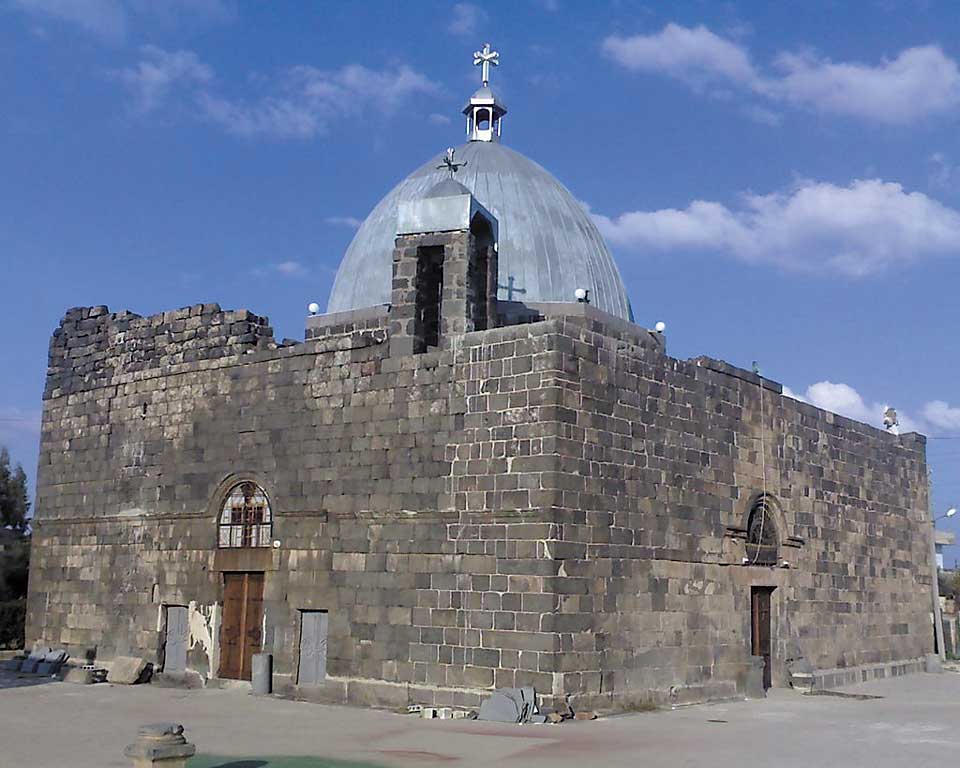
Izraa
Situated 85 Km south of Damascus is the town of Izraa'. This town is known for its two churches dating back to the 6th century, which are considered as the oldest continuously used churches in Syria. Izraa' was quite an important city in the Roman period, and later became a center of Christian importance. St. George's church was built in 515 on the site of a previous temple; a Greek inscription on its western entrance says: The House of Evil was turned into the House of God. Hymns of cherubs replaced sacrifices offered to idols and God settles here in peace, where people used to anger him. The church, made of basalt, is considered one of the main monuments of world Church architecture. After an earthquake in th ...ts two churches dating back to the 6th century, which are considered as the oldest continuously used churches in Syria. Izraa' was quite an important city in the Roman period, and later became a center of Christian importance. St. George's church was built in 515 on the site of a previous temple; a Greek inscription on its western entrance says: The House of Evil was turned into the House of God. Hymns of cherubs replaced sacrifices offered to idols and God settles here in peace, where people used to anger him. The church, made of basalt, is considered one of the main monuments of world Church architecture. After an earthquake in the early 20th century seriously damaged the church’s dome, St. George's is thought to be the oldest building in Syria which has been continuously a site of Christian (Greek Orthodox) worship. For this reason it was visited in 1890 by Nicholas II, the last Emperor of Russia when he was Crown prince; the prince financed the construction of the current dome.
Read more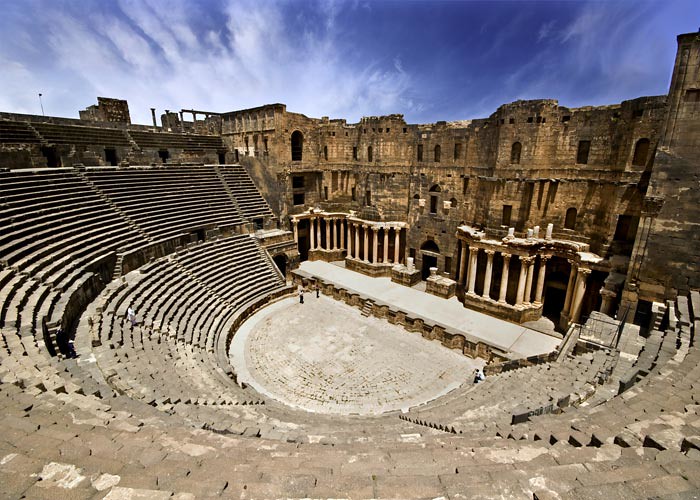
Bosra
Bosra (Dara province) Situated in the vast Hawran plain, some 145 kilometers south of Damascus. It is an extremely ancient city mentioned in the lists of Tutmose III and Akhenaten in the fourteenth century B.C. The first Nabatean city in the second century B.C, it bore the name Buhora, but during the Hellenistic period, it was known by the name of Bustra. Later the Romans took an active interest in the city, and at the time of Emperor Trajan it was made the capital of the Province of Arabia (in 106 B.C) and was called Neatrajana Bustra. The city saw its greatest period of prosperity and expansion then, became a crossroads on the caravan routes and the official seat and residence of the Imperial legate. After the decline of the Ro ...south of Damascus. It is an extremely ancient city mentioned in the lists of Tutmose III and Akhenaten in the fourteenth century B.C. The first Nabatean city in the second century B.C, it bore the name Buhora, but during the Hellenistic period, it was known by the name of Bustra. Later the Romans took an active interest in the city, and at the time of Emperor Trajan it was made the capital of the Province of Arabia (in 106 B.C) and was called Neatrajana Bustra. The city saw its greatest period of prosperity and expansion then, became a crossroads on the caravan routes and the official seat and residence of the Imperial legate. After the decline of the Roman Empire, Bosra played a significant role in the history of early Christianity. It was also linked to the rise of Islam, when a Nestorian monk called Bahira, who lived in the city, met the young Muhammad when his caravan stopped at Bosra, and predicted his prophetic vocation and the faith he was going to initiate. The oldest Islamic square minarets (still standing) are found in Bosra, whose prosperous role as an important halt for pilgrims on the way to Mecca lasted until the 17th century. The most interesting part of the city today is the famous Roman Theater built in the second century A.D, which seats 15 thousand spectators, and is considers one of the most beautiful and well preserved of Roman amphitheaters in the world. The stage is 45 meters long and 8 meters deep. Every summer, it hosts Arab and international performers who entertain audiences during the Bosra Art Festival against a majestic background of Roman columns and arches. The city itself contains a great number of Roman ruins, a part of the Byzantine Bahira church, as well as the Al Mabrak Mosque, which is said to have been erected on the site where the Prophet s camel stopped to rest. There is also the Omar Mosque, which is the only one of its type remaining from the early days of Islam, and it retains its 7th century primitive form. An important Muslim citadel, dating back to the Ayoubite and Mamluk period still stands, and one of its towers now houses a museum of Antiquities and Traditional Arts. In addition, the city has: Remains of walls (Nabatean) A triumphal arch (Roman 3rd century) Baths (Roman 2nd century) Al Birkeh (a huge pool: 155by 122 meters) (Nabatean) A Nabatean temple dating back to the first century A.D A Cathedral (Byzantine, 4th century)
Read more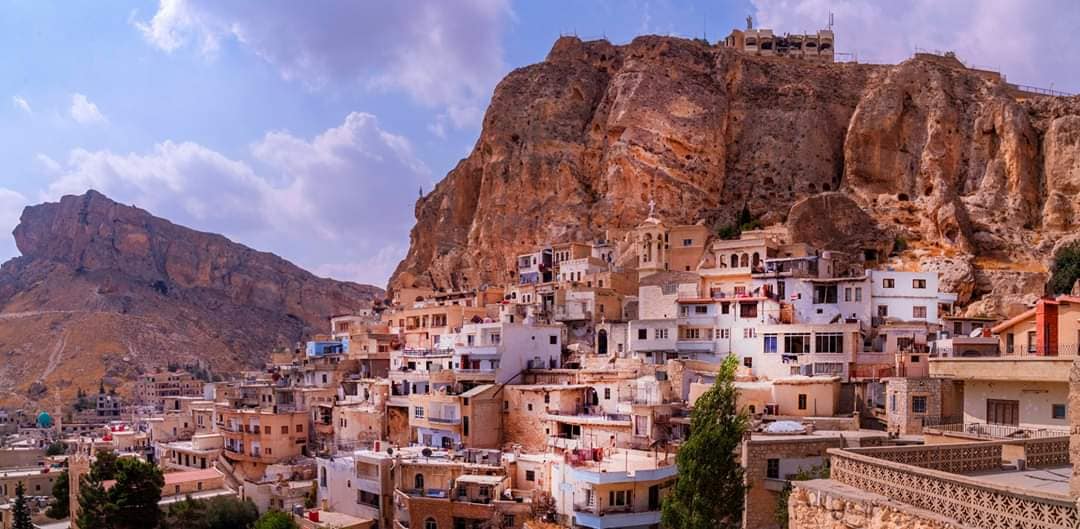
Maaloula
50 km north of Damascus; Maalula is situated at an altitude of more than 1500 meters. By far, the most important Christian site in Syria is the magnificent village of Maalula. The word Maalula means entrance in Aramaic, probably referring to the gorge in between the mountains. Maalula is the one of the few remaining villages in the world that still speak Aramaic, the language of Jesus Christ. St Sergius Chapel There are two chapels above the village whose loyalty is divided between the Greek Catholic and the Orthodox churches. The first chapel, which is of the Greek Catholics, is on the escarpment left of the gorge; the St. Sergius convent (Mar Sarkis). This tiny chapel, probably built on the site of a pagan temple, has architectural elements which go bac ...st important Christian site in Syria is the magnificent village of Maalula. The word Maalula means entrance in Aramaic, probably referring to the gorge in between the mountains. Maalula is the one of the few remaining villages in the world that still speak Aramaic, the language of Jesus Christ. St Sergius Chapel There are two chapels above the village whose loyalty is divided between the Greek Catholic and the Orthodox churches. The first chapel, which is of the Greek Catholics, is on the escarpment left of the gorge; the St. Sergius convent (Mar Sarkis). This tiny chapel, probably built on the site of a pagan temple, has architectural elements which go back to Byzantine period. Mar Sarkis is designed after the pattern of the martyrion (a shrine dedicated to a martyr) and is dedicated to Mar Sarkis (St. Sergius), a Roman soldier who was executed for his Christian beliefs. This chapel is considered one of the oldest, if not the oldest, in Christendom. On the plateau behind the church, there are also remains of ancient rock-cut tombs. St Thecla Monastery Downward into the village, on the right of the gorge, is the other chapel, a Greek Orthodox institution dedicated to St Thecla (Mar Takla), it's located in the lower monastery. Thecla was the daughter of a Seleucid prince and a young disciple of St. Paul. She is believed to be buried in the mountain just above the monastery. On the top floor is a modern church with a dome and a cave into which filters water with miraculous properties. Thecla was being pursued by soldiers of her father to capture her because of her Christian faith. She came upon a mountain, and after praying, the mountain split open and let her escape through. The town gets its name from this gap or entrance in the mountain. There are three major festivals: the Holy Cross Festival on September 14; the Festival of Mar Takla on September 22; and the festival of Mar Sarkis on October 7. Hundreds of visitors attend these celebrations and they enjoy some of the most imaginative festivals in the whole of Syria.
Read more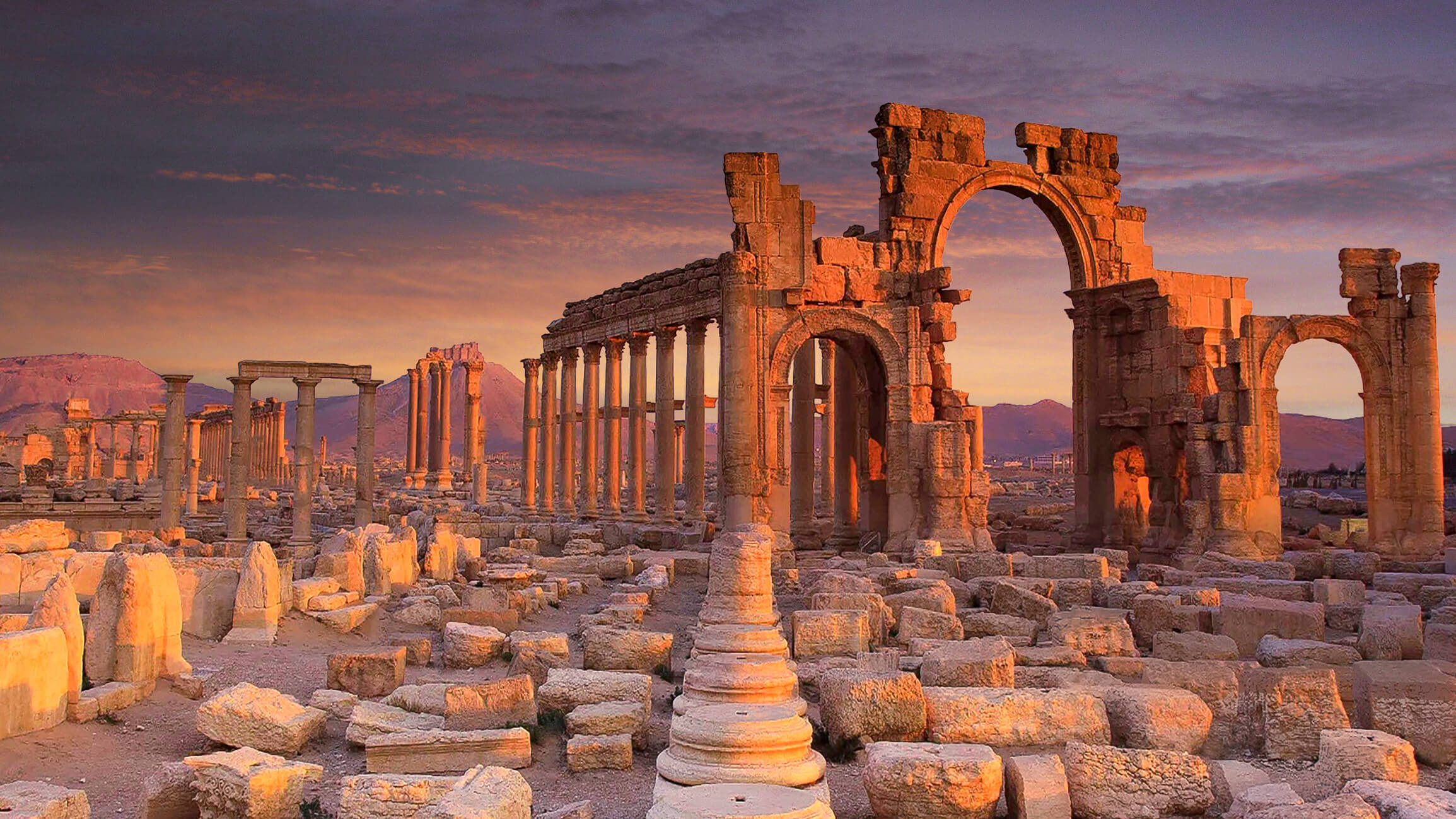
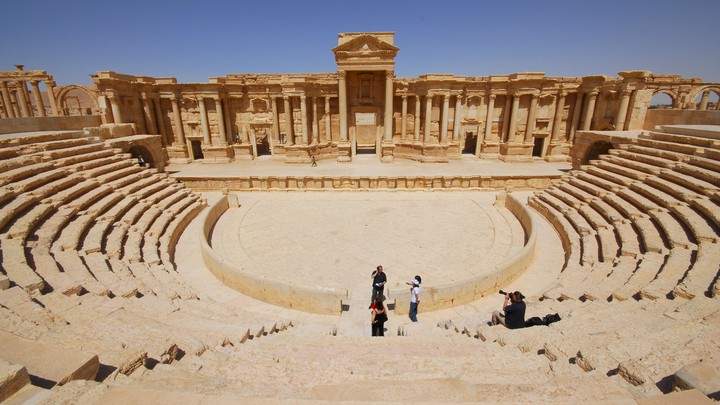
Palmyra
Palmyra contains the monumental ruins of a great city that was one of the most important cultural centres of the ancient world. From the 1st to the 2nd century, the art and architecture of Palmyra, standing at the crossroads of several civilizations, married Graeco-Roman techniques with local traditions and Persian influences. ...ntres of the ancient world. From the 1st to the 2nd century, the art and architecture of Palmyra, standing at the crossroads of several civilizations, married Graeco-Roman techniques with local traditions and Persian influences.
Read more

